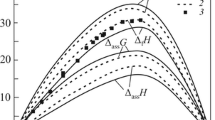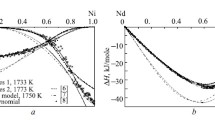The mixing enthalpies of liquid binary In–Ni alloys (0.85 < x Ni < 1) at 1800 K were determined by isoperibol calorimetry. The thermodynamic properties of the In–Ni alloys were calculated for the entire composition range using the model of ideal associated solutions. The thermodynamic activities of melt components show negative deviations from the ideal behavior. The mixing enthalpies are characterized by moderate exothermic effects. The minimum mixing enthalpy of the melts is –12.0 ± 0.1 kJ/mol at x Ni = 0.59.






Similar content being viewed by others
References
E. Hayer, K. L. Komarek, M. Gaune-Escard, and J. P. Bros, “Chemical interaction in the liquid (Co + Ga), (Co + In), (Ni + Ga), and (Ni + In) systems,” J. Non-Cryst. Solids, 156–158, 379–383 (1993).
V. V. Berezutskii, M. I. Ivanov, and G. M. Lukashenko, “Thermodynamic properties of liquid alloys of nickel and indium,” Ukr. Khim. Zh., 47, 543–546 (1981).
B. Predel, W. Vogelbein, and U. Schallner, “Thermodynamic study of the nickel–gallium system,” Thermochim. Acta, 12, 367–375 (1975).
C. Colinet, A. Bessoud, and A. Pasturel, “Thermodynamic investigation of (Ni, Pd, Pt)–(Al, In) alloys,” Z. Metallkd., 77, 798–804 (1986).
A. Pasturel and P. Hicter, “On the heats of formation of transition metal—p-metal alloys,” J. Less-Common Met., 86, 181–186 (1982).
P. Anres, R. Haddad, D. ElAllam, et al., “The limiting molar partial enthalpies of mixing of iron, cobalt, nickel, palladium, and platinum in liquid gallium and indium,” J. Alloys Compd., 220, No. 1–2, 189–192 (1995).
P. Waldner, “Prediction and thermodynamic analysis of In-activities of In–Ni alloys,” Intermetallics, 15, 532–538 (2007).
M. Ivanov, V. Berezutski, and N. Usenko, “Mixing enthalpies in liquid alloys of manganese with the lanthanides,” J. Mater. Res., 102, 277–281 (2011).
David R. Lide, Handbook of Chemistry and Physics, 84th ed., CRC Press Taylor and Francis Boca Raton, USA (2003).
A. T. Dinsdale, “SGTE data for pure elements,” Calphad, 15, No. 4, 319–427 (1991).
Author information
Authors and Affiliations
Corresponding author
Additional information
Translated from Poroshkovaya Metallurgiya, Vol. 54, No. 7–8 (504), pp. 105–111, 2015.
Rights and permissions
About this article
Cite this article
Ivanov, M.I., Berezutskii, V.V., Shevchenko, M.O. et al. Thermodynamic Properties of Binary In–Ni Alloys. Powder Metall Met Ceram 54, 465–470 (2015). https://doi.org/10.1007/s11106-015-9737-0
Received:
Published:
Issue Date:
DOI: https://doi.org/10.1007/s11106-015-9737-0




